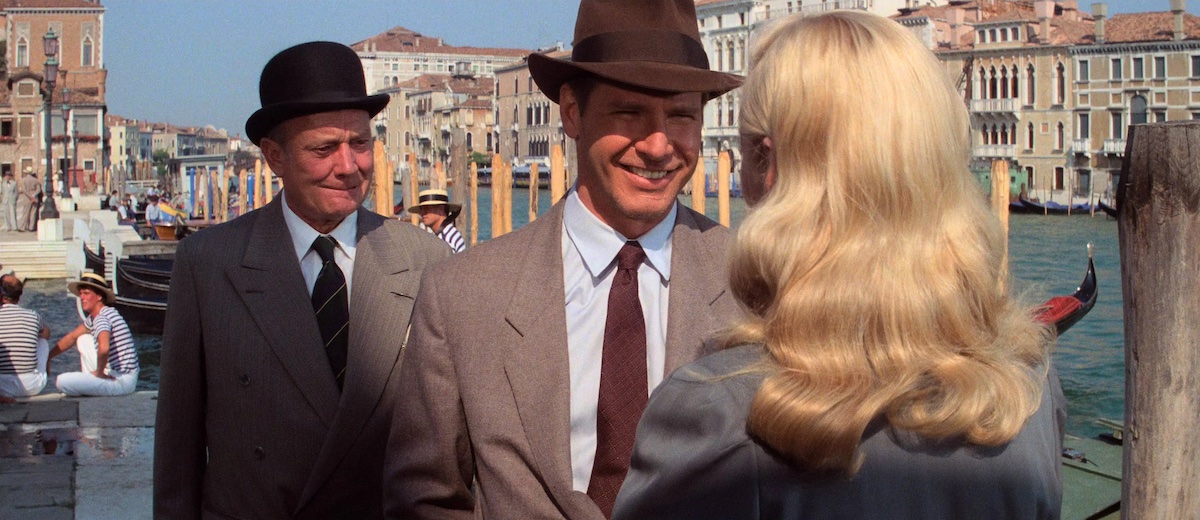Forgive me. With Indy 5 coming towards us, I had no choice but to look at my own writing archives, and resurrect this rave from 2003. Twenty years ago! Little has changed, save (I hope) my skill.
“You call this archaeology?”
For my 13th birthday, I went to see Indiana Jones and the Last Crusade with my grandmother. I was worried. I had gone through some bad experiences in the past of dragging my older relatives to the whiz-bang, popcorn adventure pictures that I grew up on, and wasn’t sure how my dear old italian grandmother was going to respond to circus trains full of snakes, property destruction in the canals of Venice, and a dapper villain aging a hundred years in moment.
She loved it. I mean, she loved it. She enjoyed the film, I think, even more than I did.
This is the great gift of Spielberg, Lucas and Ford to a generation of moviegoers… or more accurately, every generation of moviegoers, circa 1989. They had made the breakout hit, they had made the haunted house ride, and now, for the curtain call (?), they made the grandest, the classiest, the sunniest adventure of them all. A glorious call back to breezy Saturday afternoons spent in movie theatres in hometowns long gone, Last Crusade is pure pleasure. It works, not just for the kids and teens, but for everyone. I’ve never shown this film to anybody and had them come away unimpressed.
Crusade never reaches, like Temple and Raiders did, to be something more than it is. This is disapointing, and makes Crusade far and away the safest film of the trilogy. It follows the established rigours of the Indy saga to the letter — there’s the pre-title confection, the phobia scene, the display of God’s powers at the end, and enough action set pieces in the middle to lend any summer movie some serious strutting creds. Still, it’s all done with such style and charm that it manages to stay one step ahead of its own clichés.
Where Raiders was a rogue’s adventure and Temple a haunted house ride, Crusade is (overtly) a race across the surface of the earth to collect the ultimate prize. It’s a gentleman’s game, between our somewhat schizophrenic archaeology professor (who likes to dress in leather and run around tombs) and a debonair millionaire who is no less divided (and is not adverse to staining his dapper suits with the blood of those in his way). Donovan is a unique villain for the saga, a Hitchcockian manipulator who never seems to tire of showing a new set of stripes. Still, he’s no Belloq, Toht, or Mola Ram — there’s a level of menace missing here.
Covertly, Crusade is also the stuff undergrad term paper dreams are made of, following the rigours of the romantic quest to the letter. Fitting, given the artefact involved: we have a Grail, we have a knight, we even have a wise wizard, and a double-crossing witch, and a whole lot of hero deeds. Structurally, it’s the strongest of the three, an intelligently-crafted script that explores its themes on a variety of levels.
What makes Crusade so much fun in the final analysis, then, is that in addition to that romantic quest, the film draws from a parallel romantic source and gives us a healthy dollop of the ever-reliable Fisher King – this time in the form of Indy’s father, Henry Jones Senior. What a casting coup for Spielberg and company – pairing Ford with Connery is the source of everything that is truly great about Crusade, while the rest falls under the “merely competent.” Connery’s performance is such a warm one, textured with amusing bite. It’s a true classic.
Sure, it takes our once-implacable hero down a serious peg. Watching Henry slap Indy for “blasphemy” plays like a “scenes we’d like to see” card from Mad Magazine. But it gives the film two running character arcs that pay off wonderfully as the proceedings continue, with Indy learning to deal with his paternal issues, and Henry learning to lighten up a bit and start blowing up trucks. Most importantly, the relationship reinforces Indy’s need to think his way out of his problems. The three final challenges in the Grail Temple are, notably, tests of humility, intelligence, and finally, faith. Which, of course, makes them a literal extension of the same understanding that Indy had to arrive at, way back at the end of Raiders.
The principal theme of Crusade, then, as atonement, and I’ve always liked to separate out the syllables of that word, to arrive at a rather crude neologism: “at one -ment.” In order to survive this quest, Indy must become one with himself, and by extension, with his father. As I’ve said, Indy’s a schizophrenic little fellow, with his own bad parenting afoot (he sneaks out on his class when the responsibility of teaching them becomes too hairy). He’s constantly pulling between the absent-minded professor (Henry) and the dark rogue from the opening of the film, who gave him his first adventure, and his hat.
My biggest structural qualm with Crusade is that Fedora doesn’t make a return appearance in the final act, to seal the conflict for Indy, and provide some Belloqian menace to the end of the Grail quest. This makes it rather inevitable that Indy will come to be one with his father, rather than choosing the other path.
And of course, by the conclusion, Indy has atoned with his father to such an extent that Indy and Henry seem to literally be reading one another’s thoughts. This makes the climax of Crusade the most spiritual in a trilogy that is, above all, devoted to physical adventures that lead to greater spiritual ones.
